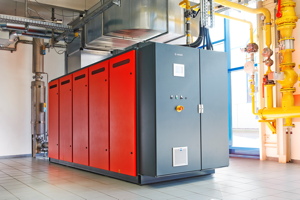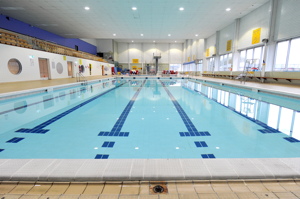Adding CHP to the boiler mix

As owners and operators of commercial buildings continue to explore how best to achieve maximum energy efficiency from their heating systems, hybrid solutions are growing in popularity. Pete Mills of Bosch Commercial & Industrial explains why combined heat and power (CHP) systems are the perfect partner for gas boilers.
One of the most widely debated topics in the commercial and industrial facilities industry is the impact of fuel costs, which are undoubtedly on the rise and stretching budgets to extremes. In light of this, we are regularly seeing instances whereby stakeholders are actively seeking alternative solutions to meet their energy requirements.
When it comes to the provision of heating and hot water in a commercial environment, one of the growing trends is the installation of a systems alliance, whereby a secondary or accompanying technology is installed alongside a boiler to utilise the strengths of each appliance in order to mitigate the impact of rising energy costs and increasingly stringent emissions targets.
One such arrangement for applications with sufficient demand for both electricity and heat is the incorporation of a combined heat and power (CHP) module. As heat is produced as a by-product of the power generated and by distributing via a thermal store, the technology lends itself to operation alongside any other heating source — a high-efficiency boiler being one of the most common examples.
The key to a successful systems alliance comprising CHP is that the system is designed to utilise 100% of the heat generated. With premium efficiency levels and cost savings being the ultimate objective for such an arrangement, it is vital that no heat is rejected, which would have the potential to jeopardise the system’s effectiveness and compromise the cost saving benefit. To avoid the dumping or wastage of heat, it is absolutely essential that the CHP module is correctly sized. Failure to do so from the outset of a project is likely to result in the production of too much heat for a building, which will nullify any potential performance enhancements.
 |
| The key to a successful systems alliance comprising CHP is that the system is designed to utilise 100% of the heat generated. |
In most cases, CHP units are installed in tandem with boilers. However it is also possible to utilise the benefits of an alternative appliance. Whatever the arrangement, the key to reaping the benefits of a CHP system is to ensure it is sized either to the thermal base load of a project, or 20% of the peak load, to allow for maximum efficiency. Whilst CHP will meet a building’s base-heating-load requirements most of the time, a secondary source will be required in most cases to satisfy a building’s peak heating load. In some instances this may only equate to a few months a year, but during these times, CHP alone would not be the most efficient solution.
A well thought out system design will increase the likelihood of a favourable return on investment, which will in turn lead to quicker payback on the initial financial outlay. Further benefits can be taken advantage of through Government incentives, with the CRC Energy Efficiency Scheme standing as a mandatory requirement for larger organisations to reduce their emissions — a goal the integration of a suitably-sized CHP module is likely to help them to achieve. Provided the appliance meets the registration criteria, CHP can also enable non-domestic stakeholders to take advantage of the Enhanced Capital Allowance (ECA) scheme, which provides tax relief and improves cashflow for the year that the new equipment is purchased.
Although new installations generally lend themselves to a more effective system design, CHP can also be integrated as part of an existing system in a retrofit arrangement. With access to an extensive history of energy data, a manufacturer will be able to work in co-operation with the project consultant to ensure the CHP module is correctly sized and that the arrangement best meets the application’s requirements.
Whilst correct sizing will go some way to maximising performance, as with a boiler, once the CHP is installed, it is vital to take care of the long-term health of the system. Investing in a maintenance agreement is something that should be considered an essential commitment. This is not purely down to manufacturers wanting customers to spend more money on their installation, but because investing in CHP without being prepared to invest in the long-term running of the system is a huge false economy for investors.
 |
| CHP systems are ideal for buildings with constant demand for electricity and heating — such as leisure centres |
If CHP units are not correctly maintained post installation there is a risk of the engine breaking down. And when that happens, rebuilding the engine comes with a large cost attached. It is not surprising that many owners who purchased modules without a maintenance agreement decide to switch them off rather than go the expense of rectifying the problem.
Investing in a maintenance contract will help any new project overcome initial teething problems, and then allow the module to operate in harmony within a systems alliance. Whilst it may be tempting for investors not to budget for a maintenance agreement, after spending money on the CHP installation itself, it is likely to prove a costly decision over the longer term as it is impossible for CHP to deliver what it has been designed to contribute without it operating.
Pete Mills is commercial technical operations manager at Bosch Commercial & Industrial.







